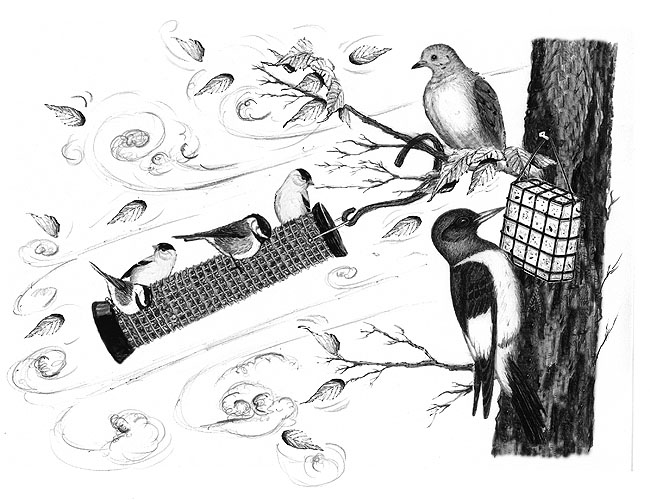
Dear Bird Folks,
It’s been days since Hurricane Irene blew through our area and I’m still sitting in the dark waiting for the electric company to restore my power. With so much time on my hands I’ve been wondering how the birds are doing. How do they manage to deal with such powerful storms? Hurricanes must take a toll on them.
– Sheryl, Marion, MA
They are smart, Sheryl,
Birds are able survive storms because evolution has provided them with the instincts needed to deal with all sorts of environmental hazards. Birds also able to learn. Through trial and error, and by watching others of their species, birds quickly learn to avoid deadly pitfalls. Most creatures with higher intelligence have the ability to learn from their mistakes. The exception to this rule, of course, is the executives of the electric companies. No matter how many times their utility poles are knocked down by storms, they keep having them put right back up, only to see them get knocked down again. Evidently, all the dodos aren’t extinct.
Hurricanes are complicated weather systems. We got plenty of wind at my house, but not a single drop of rain. Meanwhile, the poor folks in Vermont got enough rain to make Noah nervous. Birds’ responses to such storms are equally complicated. Seabirds, for example, don’t bother fighting the strong winds. Instead they tend to ride along with the powerful winds until they can safely escape. Sometimes they don’t escape until they are hundreds of miles from their normal range, where they are greeted by dozens of work-skipping birders. Songbirds, on the other hand, try to stay out of the severe wind. They duck into low foliage and ride out the storm by clinging to branches with their strong feet. But woodpeckers may be the smartest of the bunch. They avoid storms by safely hiding inside tree cavities. Well, they are safe until tree they are hiding in gets knocked down. Then they are on the phone with their insurance company, just like the rest of us.
Shorebirds, living on exposed mudflats, seem to be the most vulnerable. But they have learned to drop behind the nearest dune or ridge to avoid the ravaging winds. Last fall I was birding from my car on the backside of Duxbury Beach. As I watched a flock of Dunlins (sandpipers) the sky suddenly became jet black and a fierce squall came roaring across Duxbury Harbor. Storm clouds started spitting out sheets of rain and hail, while gale force winds sandblasted the paint off my car. Through all the craziness I kept my eyes on the Dunlins. I was interested in seeing how the birds would respond to the squall. The wind arrived so quickly and with such fury that a few of the birds were actually knocked over before they could react. But they quickly recovered and took to the air. I expected them to fly as fast as they could to get away from the pocket of nasty weather. However, they only flew about twenty feet and dropped into a shallow depression behind some beach grass. There they hunkered down until the wind subsided, at which point they went back to feeding as if nothing had happened. I learned two things that day. First, shorebirds know how to deal with strong wind; and second, the next time I go birding on Duxbury Beach I should borrow someone else’s car.
It has long been theorized that birds are able to predict approaching storms. This was clearly evident with Irene. Just about every customer reported seeing more birds than usual on their feeders the day before the storm arrived. Even during the height of the storm, many people saw birds chowing on their feeders, which were nearly horizontal in the wind. The most logical reason for this extra food consumption is to provide the birds the energy needed to deal with the nasty weather. There’s also another little-known theory and it has to do with weight gain. The birds think that the fatter they are, the least likely they’ll be blown away. I totally subscribe to this theory. That’s why I ate all of the ice cream in our freezer…even before the power went out.
Most backyard birds are ultimately affected very little by tropical storms, but it’s a different story for migrating birds. Many birds migrate by flying over the open ocean. When they run into bad weather they do their best to fly over or around it, but sometimes they can’t. When this happens the birds eventually become exhausted and end up in the oceanic food chain. But this is not always the case. It seems one particular bird, which was being tracked by researchers, did just fine. A Whimbrel (another sandpiper), named “Chinquapin” left its breeding grounds in Canada, only to run into our pal Irene. It somehow battled the hurricane for four long days without ever landing. Finally, the tired bird managed to set down on a beach somewhere in the Bahamas, where it was immediately approached by a local guy who tried to sell it a shell necklace and an imitation Rolex watch.
Birds have been dealing with hurricanes for centuries, Sheryl, and for the most part their instincts and their ability to learn have served them quite well. It’s too bad the big shots at the electric companies can’t seem to figure out that hanging power lines on exposed poles isn’t the best way to keep them out of harm’s way. I guess things could always be worse. The wastewater department could hang the sewer lines from poles, too. And we thought bird poop falling from the sky was gross.